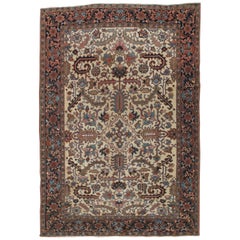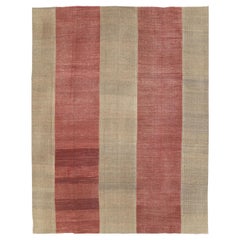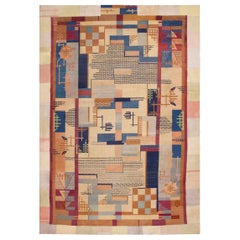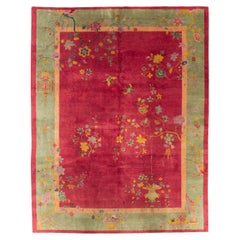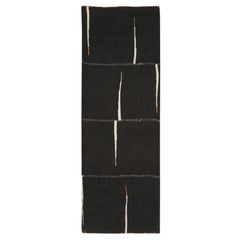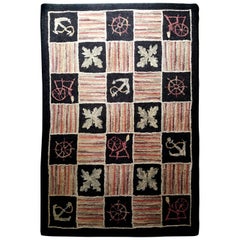New York - More Carpets
to
1,116
Width
to
Length
to
4,364
1,578
98
1,255
243
130
80
65
64
43
21
19
18
12
10
2
2
44
490
3,830
1,676
1,369
1,387
196
57
46
107
64
32
66
51
38
16
8
5,952
5,363
278
671
293
6,040
24,704
3,137
6,040
5,440
5,558
5,281
4,140
2,088
2,051
1,916
155
117
63
46
38
Item Ships From: New York
Antique Persian Heriz Carpet, Handmade Wool Oriental Rug, Ivory and Light Blue
Located in Port Washington, NY
Heriz carpets are the staple of the furnishing market and remain the most popular of all NW Persian Carpets. They were produced for the rapidly growing US market in the late 19th-ear...
Category
1920s Persian Heriz Serapi Vintage New York - More Carpets
Materials
Wool
$4,500 Sale Price
43% Off
Mid-20th Century Handmade Turkish Flatweave Kilim Room Size Carpet
Located in New York, NY
A vintage Turkish flatweave Kilim room size carpet handmade during the mid-20th century.
Measures: 10' 1" x 13' 2".
Category
Mid-20th Century Turkish Rustic New York - More Carpets
Materials
Wool
Vintage Art Deco Indian Rug. Size: 12 ft 7 in x 18 ft 7 in
Located in New York, NY
Vintage Art Deco Rug, Country Of Origin: India, Circa date: Early 20th century. Size: 12 ft 7 in x 18 ft 7 in (3.84 m x 5.66 m)
Category
Early 20th Century Indian Art Deco New York - More Carpets
Materials
Wool
Mid-20th Century Handmade Chinese Art Deco Room Size Carpet
Located in New York, NY
A vintage Chinese Art Deco room size carpet handmade during the mid-20th century.
Measures: 8' 10" x 11' 8".
Category
Mid-20th Century Chinese Art Deco New York - More Carpets
Materials
Wool
Contemporary Handmade Turkish Flatweave Kilim Small Runner
Located in New York, NY
A modern Turkish flatweave Kilim small runner handmade during the 21st century.
Measures: 2' 4" x 6' 3".
Category
21st Century and Contemporary Turkish Modern New York - More Carpets
Materials
Wool
Vintage Nautical Theme American Hook Rug
Located in New York, NY
This spectacular vintage American, most likely Maine, hooked rug is extremely visual with a stunning myriad of colors contained within a striped border with spinning wheel and nautic...
Category
1920s American Folk Art Vintage New York - More Carpets
Materials
Wool
Early 20th Century Handmade Persian Mahal Room Size Carpet
Located in New York, NY
An antique Persian Mahal room size carpet handmade during the early 20th century.
Measures: 8' 9" x 12' 6".
Category
Early 20th Century Persian Rustic New York - More Carpets
Materials
Wool
Mid-20th Century Handmade Persian Kashan Accent Rug
Located in New York, NY
A vintage Persian Kashan accent rug handmade during the mid-20th century.
Measures: 3' 6" x 6' 4"
Persian rugs & carpets:
Persia (Iran) is a moderately large country with a ve...
Category
Mid-20th Century Persian Rustic New York - More Carpets
Materials
Wool
cc-tapis Rug Tapis Paysage Au Soleil by Cristina Celestino for Maison Matisse
By Cristina Celestino, cc-tapis
Located in Brooklyn, NY
Born in France. Designed in Milan. Produced in Nepal.
cc-tapis is an Italian company which produces contemporary hand-knotted rugs which are created in Nepal by expert Tibetan artis...
Category
21st Century and Contemporary Nepalese Modern New York - More Carpets
Materials
Wool, Silk
Tribal Mid-20th Century Handmade Turkish Anatolian Square Room Size Carpet
Located in New York, NY
A vintage Turkish Anatolian square room size carpet handmade during the mid-20th century with a large scale tribal design over a solid orange background with light and dark striation...
Category
Mid-20th Century Turkish Tribal New York - More Carpets
Materials
Wool
$19,400 Sale Price
20% Off
Antique Persian Tabriz Oriental Carpet in Small Size with Central Medallion
Located in New York, NY
Antique Perisan Tabriz oriental carpet, circa 1900, small Sized
An antique Persian Tabriz oriental carpet, circa 1900. Size: 5'7" x 4'2". This small sized antique decorative rug w...
Category
Early 1900s Persian Antique New York - More Carpets
Materials
Wool
$2,556 Sale Price
20% Off
Traditional Persian Square Rug Pillow
Located in New York, NY
Square size Pillow made from a Persian Lilihan rug. zipper closure and poly-fill insert provided.
Measures: 19'' x 19''.
Category
20th Century Tabriz New York - More Carpets
Materials
Wool, Cotton
Early 20th Century Handmade Persian Serapi Large Room Size Carpet
Located in New York, NY
An antique Persian Serapi (grade term for higher quality Heriz rugs) large room size carpet handmade during the early 20th century.
Measures: 11' 10" x 15' 6".
Category
Early 20th Century Persian Colonial Revival New York - More Carpets
Materials
Wool
Early 20th Century Handmade Persian Tabriz Accent Rug
Located in New York, NY
A vintage Persian Tabriz accent rug handmade during the early 20th century.
Measures: 4' 0" x 5' 8".
Category
Early 20th Century Persian Tabriz New York - More Carpets
Materials
Wool
Vintage Mid-20th Century Turkish Sivas Deco Rug
Located in New York, NY
A vintage Turkish Sivas deco carpet from the mid-20th century.
Measures: 6' 5" x 9' 7".
Category
Mid-20th Century Turkish Art Deco New York - More Carpets
Materials
Wool
$7,600 Sale Price
20% Off
Schumacher Branson 9' x 12' Jute Rug In Natural
By Schumacher
Located in New York, NY
This rug will ship in December. A substantial flatweave made of 100% jute, Branson offers a textural lattice design with fabulous tonal variations. Inspired by our Branson Embroidery fabric...
Category
21st Century and Contemporary American Modern New York - More Carpets
Materials
Jute
$2,940 / item
Early 20th Century Handmade Persian Malayer Runner
Located in New York, NY
An antique Persian Malayer rug in runner format handmade during the early 20th century.
Measures: 2' 10" x 13' 3"
Persian Rugs & Carpets:
Persia (Iran) is a moderately large c...
Category
Early 20th Century Persian Victorian New York - More Carpets
Materials
Wool
Doris Leslie Blau Mid-20th Century Green Swedish Flat-Woven Rug
Located in New York, NY
Mid-20th century Green Swedish flat-woven rug
Size: 6'7" × 11'4" (200 × 345 cm)
A striking example of mid-century Scandinavian textile design, this vintage Swedish flat weave rug com...
Category
Mid-20th Century Swedish Mid-Century Modern New York - More Carpets
Materials
Wool
Mid-20th Century Handmade Persian Malayer Throw Rug
Located in New York, NY
A vintage Persian Malayer throw rug handmade during the mid-20th century.
Measures: 1' 10" x 2' 10".
Category
Mid-20th Century Persian Rustic New York - More Carpets
Materials
Wool
Mid-20th Century Handmade Persian Tabriz Square Throw Rug
Located in New York, NY
A vintage Persian Tabriz throw rug in square format handmade during the mid-20th century.
Measures: 2' 1" x 2' 7".
Category
Mid-20th Century Persian Modern New York - More Carpets
Materials
Wool
Early 20th Century Handmade Persian Kurd Throw Rug In Light Brown And Blue Green
Located in New York, NY
An antique tribal throw rug handmade by the Kurdish tribes of Persia during the early 20th century. An unusually large-scaled classic "Herati" pattern, for a small throw rug, over a ...
Category
Early 20th Century Persian Tribal New York - More Carpets
Materials
Wool
$2,080 Sale Price
20% Off
Mid-20th Century Handmade Chinese Art Deco Throw Rug
Located in New York, NY
A vintage Chinese Art Deco throw rug handmade during the mid-20th century.
Measures: 3' 1" x 4' 11".
Category
Mid-20th Century Chinese Art Deco New York - More Carpets
Materials
Wool
Antique Persian Tabriz Oriental Carpet in Room Size with Central Medallion
Located in New York, NY
Antique Persian Tabriz Oriental Carpet, circa 1900, Room Sized
An antique Persian Tabriz oriental carpet, circa 1900. Size: 12'9" x 9'2". This large sized antique decorative rug wa...
Category
Early 1900s Persian Antique New York - More Carpets
Materials
Wool
$19,196 Sale Price
20% Off
Schumacher Tortola 9' x 12' I/O Rug In Sky
By Schumacher
Located in New York, NY
This rug will ship in December. Made of soft yet super-durable PET, Tortola is as stylish as it is practical. Inspired by one of our bestselling indoor/outdoor textiles...
Category
21st Century and Contemporary American Modern New York - More Carpets
Materials
Polyester
$3,115 / item
Mid-20th Century Handmade Persian Art Deco Style Mahal Throw Rug
Located in New York, NY
A vintage Persian Art Deco style Mahal throw rug handmade during the mid-20th century.
Measures: 2' 9" x 6' 4".
Category
Mid-20th Century Persian Art Deco New York - More Carpets
Materials
Wool, Cotton
Early 20th Century Handmade Persian Chintamani Mahal Large Room Size Carpet
Located in New York, NY
An antique Persian Mahal large room size carpet handmade during the early 20th century with the ancient Buddhist design, Chintamani (often spelled Cintamani), over a rust red field w...
Category
Early 20th Century Persian Rustic New York - More Carpets
Materials
Wool
Zabihi Collection Antique Turkish Sivas Runner
Located in New York, NY
An early 20th-century fine colorful Turkish Sivas runner
Measures: 3'3'' x 9'1''.
Category
20th Century Turkish Agra New York - More Carpets
Materials
Wool
Early 20th Century Handmade Persian Tabriz Accent Rug
Located in New York, NY
An antique Persian Tabriz accent rug handmade during the early 20th century.
Measures: 4' 6" x 6' 4".
Category
Early 20th Century Persian Tabriz New York - More Carpets
Materials
Wool
Vintage Turkish Art Deco Runner
Located in New York, NY
A vintage Turkish Art Deco runner handmade during the mid-20th century.
Category
Mid-20th Century Turkish Art Deco New York - More Carpets
Materials
Wool
cc-tapis Orizzonti Scaccomatto Rug by Eligo Studio
By cc-tapis, Eligo
Located in Brooklyn, NY
Proudly hand woven in India.
Category
21st Century and Contemporary Indian Modern New York - More Carpets
Materials
Bamboo
$4,410 / item
Early 20th Century Handmade Persian Bidjar Throw Rug
Located in New York, NY
An antique Persian Bidjar throw rug handmade during the early 20th century.
Measures: 3' 8" x 6' 4".
Category
Early 20th Century Persian Rustic New York - More Carpets
Materials
Wool
Mid-20th Century Handmade Persian Mashad Art Deco Square Accent Rug
Located in New York, NY
A vintage Persian Mashad Art Deco square accent rug handmade during the mid-20th century.
Measures: 4' 11" x 5' 9".
Category
Mid-20th Century Persian Art Deco New York - More Carpets
Materials
Wool
Zabihi Collection Antique Persian Neutral Color Heriz Rug
Located in New York, NY
A whitewashed Karadja Heriz rug from the 20th century
Details
rug no. j4529
size 7' 10" x 11' 2" (239 x 340 cm)
Category
20th Century Persian Tudor New York - More Carpets
Materials
Wool
Tribal Mid-20th Century Handmade Central Asian Turkoman Room Size Carpet
Located in New York, NY
A vintage Central Asian tribal Turkoman room size carpet handmade during the mid-20th century.
Measures: 9' 10" x 12' 4".
Category
Mid-20th Century Central Asian Tribal New York - More Carpets
Materials
Wool
Contemporary Handmade Turkish Patchwork Style Flatweave Throw Rug
Located in New York, NY
A modern Turkish Patchwork style flatweave throw rug handmade during the 21st century using remnants of vintage Turkish flatweaves from the mid-20th century.
Measures: 3' 1" x 4' 2".
Category
21st Century and Contemporary Turkish Modern New York - More Carpets
Materials
Wool
Rustic Mid-20th Century Handmade Distressed Persian Shiraz Accent Rug
Located in New York, NY
A vintage Persian Shiraz accent rug with a rustic appeal and tribal design handmade during the mid-20th century. The rug has a textured, weathered and distressed, feel but the founda...
Category
Mid-20th Century Persian Rustic New York - More Carpets
Materials
Wool
cc-tapis Tidal Collection Wave Yellow Pink Rug by Germans Ermičs
By Germans Ermics, cc-tapis
Located in Brooklyn, NY
The Tidal collection is a visual investigation into the relationship between texture, shape and color. A sophisticated gradient effect was created through an entirely new coloring sy...
Category
21st Century and Contemporary Nepalese Modern New York - More Carpets
Materials
Wool
Modern Textured Wool Rug with Geometric Chevron Design by Doris Leslie Blau
Located in New York, NY
Contemporary Textured Wool Rug with Geometric Chevron Design by Doris Leslie Blau.
Size: 20.9" × 25.8" (632 × 782 cm).
Crafted with artistic precision, this contemporary high-low woo...
Category
21st Century and Contemporary Moroccan Modern New York - More Carpets
Materials
Wool
Mid-20th Century Handmade Persian Pictorial Bakhtiari Accent Rug
Located in New York, NY
A vintage Persian pictorial Bakhtiari gallery rug handmade during the mid-20th century.
Measures: 4' 11" x 8' 4".
Category
Mid-20th Century Tribal New York - More Carpets
Materials
Wool
Antique Persian Serapi Rug. Size: 10 ft 7 in x 12 ft 2 in
Located in New York, NY
Room Size Antique Persian Serapi Rug, Country of origin: Persia, Circa date: 1900. Size: 10 ft 7 in x 12 ft 2 in (3.23 m x 3.71 m)
Category
20th Century Persian Serapi New York - More Carpets
Materials
Wool
Mid-20th Century Handmade Persian Malayer Throw Rug
Located in New York, NY
A vintage Persian Malayer throw rug handmade during the mid-20th century.
Measures: 3' 6" x 5' 4"
Persian Rugs & Carpets:
Persia (Iran) is a moderately large country with a ve...
Category
Mid-20th Century Persian Rustic New York - More Carpets
Materials
Wool
Early 20th Century Handmade Persian Kurd Runner
Located in New York, NY
An antique Persian Kurd runner handmade during the mid-20th century.
Measures: 3' 2" x 9' 11".
Category
Early 20th Century Persian Rustic New York - More Carpets
Materials
Wool
Antique Persian Khorassan Rug. Size: 8' 7" x 10' 10"
Located in New York, NY
Extremely decorative light blue and soft brown room size Antique Persian Khorassan rug, country of origin / rug type: Antique Persian rugs, Date: circa early 20th century. Size: 8 ft...
Category
Early 20th Century Persian Khorassan New York - More Carpets
Materials
Wool
Mid-20th Century Handmade Persian Hamadan Throw Rug
Located in New York, NY
A vintage Persian Hamadan throw rug handmade during the mid-20th century.
Measures: 3' 1" x 6' 9".
Category
Mid-20th Century Persian Rustic New York - More Carpets
Materials
Wool, Cotton
Early 20th Century Handmade Persian Malayer Throw Rug
Located in New York, NY
An antique Persian Malayer throw rug handmade during the early 20th century.
Measures: 3' 7" x 5' 0"
Persian rugs & carpets:
Persia (Iran) is a moderately large country with a...
Category
Early 20th Century Persian Rustic New York - More Carpets
Materials
Wool
European Folk Stamverband II Goat Hair Rug by Doris Leslie Blau
Located in New York, NY
European Folk Stamverband II goat hair rug by Doris Leslie Blau.
Size: 4'5" × 7'0" (134 × 213 cm).
This stunning contemporary rug was handmade using the highest quality wool, ensurin...
Category
21st Century and Contemporary Dutch Modern New York - More Carpets
Materials
Goat Hair
Mid-20th Century Handmade Persian Hamadan Throw Rug
Located in New York, NY
A vintage Persian Hamadan throw rug handmade during the mid-20th century.
Measures: 3' 0" x 5' 6"
Persian Rugs & Carpets:
Persia (Iran) is a moderately large country with a ve...
Category
Mid-20th Century Persian Rustic New York - More Carpets
Materials
Wool
Mid-20th Century Handmade Persian Malayer Accent Rug
Located in New York, NY
A vintage Persian Malayer accent rug handmade during the mid-20th century.
Measures: 4' 8" x 6' 10".
Category
Mid-20th Century Persian Rustic New York - More Carpets
Materials
Wool
Rug & Kilim’s Mid-Century Modern Rug In Green And White Geometric Patterns
By Rug & Kilim
Located in Long Island City, NY
Hand-knotted in wool and all natural silk, this modern 4×6 rug hails from the latest additions to the Mid-Century Modern Collection by Rug & Kilim — the first representation of varie...
Category
2010s Indian Mid-Century Modern New York - More Carpets
Materials
Wool
Mid-20th Century Handmade Persian Malayer Accent Rug
Located in New York, NY
A vintage Persian Malayer accent rug handmade during the mid-20th century.
Measures: 4' 9" x 6' 9".
Category
Mid-20th Century Rustic New York - More Carpets
Materials
Wool
Contemporary Handmade Turkish Flat-Weave Kilim Large Geometric Room Size Carpet
Located in New York, NY
A modern Turkish flat-weave Kilim large room size carpet handmade during the 21st century with a geometric large scale diamond-shaped pattern in earth tones with an overall khaki gre...
Category
21st Century and Contemporary Turkish Modern New York - More Carpets
Materials
Wool
cc-tapis Rug Fuga Scene 3 by Cristian Mohaded
By Cristian Mohaded, cc-tapis
Located in Brooklyn, NY
Born in France. Designed in Milan. Produced in Nepal.
cc-tapis is an Italian company which produces contemporary hand-knotted rugs which are created in Nepal by expert Tibetan artis...
Category
21st Century and Contemporary Nepalese Modern New York - More Carpets
Materials
Wool
$8,453 / item
Nazmiyal Collection Antique Persian Tehran Rug. 10 ft 1 in x 13 ft 8 in
Located in New York, NY
Magnificent Antique Persian Tehran Animal Design Area Rug, Country of Origin / rug type: Persian rug, Circa date: 1900. Size: 10 ft 1 in x 13 f...
Category
20th Century Persian Other New York - More Carpets
Materials
Wool
Early 20th Century Handmade Chinese Art Deco Throw Rug
Located in New York, NY
An antique Chinese Art Deco throw rug handmade during the early 20th century.
Measures: 2' 0" x 3' 9".
Category
Early 20th Century Chinese Art Deco New York - More Carpets
Materials
Wool
Mid-20th Century Handmade Persian Flatweave Kilim Accent Rug
Located in New York, NY
A vintage Persian flatweave Kilim accent rug handmade during the mid-20th century.
Measures: 6' 8" x 8' 4".
Category
Mid-20th Century Persian Bohemian New York - More Carpets
Materials
Wool
Contemporary Handmade Turkish Flatweave Kilim Accent Rug
Located in New York, NY
A modern Turkish flatweave Kilim accent rug handmade during the 21st century.
Measures: 6' 8" x 9' 7".
Category
21st Century and Contemporary Turkish Modern New York - More Carpets
Materials
Wool
Zabihi Collection Antique Persian Oversize Bidjar Rug
Located in New York, NY
An early 20th-century Brown and gray Persian Bidjar Oversize Rug
Details
rug no. j4061
size 12' 8" x 18' 5" (386 x 561 cm)
Category
Early 20th Century Persian American Colonial New York - More Carpets
Materials
Wool
Angora "Tulu" Rug
Located in New York, NY
Angora "Tulu" rug. A very high quality, luminous example of this type of rug. Rug has great colors.
Category
1950s Turkish Tulu Vintage New York - More Carpets
Materials
Angora
$795 Sale Price
59% Off
Mid-20th Century Handmade Persian Malayer Throw Rug
Located in New York, NY
A vintage Persian Malayer throw rug handmade during the mid-20th century.
Measures: 3' 5" x 5' 11".
Category
Mid-20th Century Persian Rustic New York - More Carpets
Materials
Wool
Art Deco Inspired Mid-20th Century Handmade Persian Mashad Room Size Carpet
Located in New York, NY
A vintage Persian Mashad room size carpet handmade during the mid-20th century with a Minimalist, yet geometric Art Deco inspired design.
Measures: 9' 1" x 13' 7".
Category
Mid-20th Century Persian Art Deco New York - More Carpets
Materials
Wool
Recently Viewed
View AllMore Ways To Browse
Antique Meissen Dinner Plates
Antique Monogrammed Napkins
Antique Napoleon Fireplace Screen
Antique Nippon Porcelain
Antique Perfume Cabinet
Antique Porcelain Water Jugs
Antique Pug Figurine
Antique Reaper
Antique Red Riding Hood
Antique Sewing Birds
Antique Silver Baby Cups
Antique Silver Cruet Condiment Sets
Antique Silver Music Box
Antique Silver Nutcracker
Antique Soldier Figurines
Antique Solingen
Antique Station Of The Cross
Antique Sterling Silver Pin Cushion
